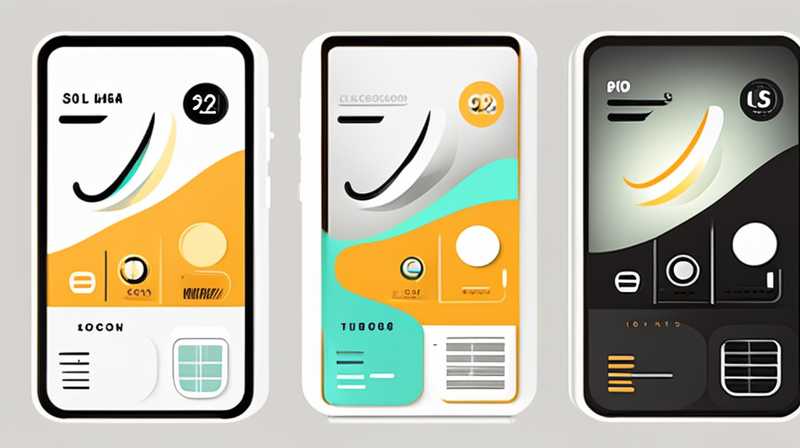
To effectively reduce the power of a 32V solar light, several methods can be employed that provide optimal functionality and comfort. 1. Adjusting voltage requirements, 2. Implementing resistive loads, 3. Utilizing dimmers, 4. Modifying the light’s configuration. For instance, adjusting voltage requirements entails configuring the solar light to operate at a reduced voltage, ensuring an energy-efficient performance without compromising the quality of illumination. This necessitates an understanding of the solar light’s specifications and may involve using voltage regulators or buck converters designed specifically for this purpose. Practically, this can lead to enhanced battery longevity and decreased energy consumption, which is crucial for sustainable lighting solutions, particularly in off-grid scenarios.
1. UNDERSTANDING VOLTAGE IN SOLAR LIGHTS
Solar lighting systems operate by converting solar energy into electrical energy, providing illumination without reliance on conventional power sources. The design of these lights typically includes photovoltaic panels, batteries, and light-emitting diodes (LEDs). Each component plays a significant role in determining the system’s efficiency and performance. Voltage regulation is essential because it dictates how effectively the light utilizes the stored energy from solar panels.
The photovoltaic panel generates electricity based on sunlight exposure, converting sunlight to a specific voltage, commonly higher than standard outputs. For a solar light rated at 32 volts, it is pivotal to understand how the light’s inherent design responds to this voltage. If the voltage exceeds the components’ tolerance levels, it could lead to overheating or, ultimately, failure of the lighting system. Hence, using voltage regulation techniques to lower the output can prevent potential damages and elongate the lifespan of the entire assembly.
2. ADJUSTING VOLTAGE REQUIREMENTS
Lowering the voltage of a solar light involves the use of various techniques, most prominently voltage regulators or buck converters. These devices allow users to adjust the voltage output to a desired level without compromising the light’s brightness excessively. Typically, this can involve interval checks and adjustments based on usage patterns, ensuring that energy consumption remains efficient.
Implementing this measure requires a calculated approach. For instance, determining the optimal voltage for the environment in which the solar light will be used is paramount. Not all settings will necessitate peak performance; thus, understanding the typical operational needs based on seasonal variability should guide adjustments. Once the voltage is regulated, users will likely notice an improvement in battery performance, as reduced operational voltage tends to minimize the energy drain experienced during heavy usage.
3. IMPLEMENTING RESISTIVE LOADS
To mitigate power consumption further, incorporating resistive loads provides a functional pathway toward reducing overall power utilized by the 32V solar light. This method includes the installation of resistors to dissipate excess energy as heat rather than lighting up components unnecessarily. Resistors can be placed strategically in the circuit, ensuring that the correct amount of current flows through the system without resulting in over-powering the LEDs.
The application of resistive loads not only serves to moderate energy consumption but also enhances the thermal management of the solar lighting system. Excessive energy can lead to overheating, damaging sensitive components over time. By calculating the appropriate resistance value and incorporating resistors effectively, one can achieve a balance between performance and safety, prolonging the operational life of the solar light.
4. UTILIZING DIMMERS
Another innovative method to effectively manage the intensity of illumination is through the implementation of dimmers. Dimmer switches allow users to control the luminous output according to specific requirements, enabling them to decrease power draw significantly during periods when full brightness is unnecessary. Through this technique, not only can power consumption be reduced, but it also cultivates a more controlled and comfortable lighting environment.
Selecting the right type of dimmer is crucial. Certain dimmers are specifically designed for LED applications, ensuring compatibility and maintaining efficiency. The potential to adjust lighting throughout the day or according to individual preference fosters an adaptive lighting strategy. Users can vary the brightness based on time or need, ultimately preserving battery life and enhancing personal comfort and satisfaction levels.
5. MODIFYING THE LIGHT’S CONFIGURATION
The physical configuration of the solar light can also play a significant role in energy consumption. Modifying the angles, positioning of the solar panel, and the type of LED used can affect not just brightness but overall functionality. Altering these configurations can optimize energy absorption, ensuring that the light is not overpowered, especially when relying on stored energy, and managing illumination requirements effectively.
Alterations can include adjusting the angle of solar panels to capture more sunlight or optimizing the LED array to produce sufficient lighting at a lower voltage. Each of these strategies can contribute to a well-functioning, energy-efficient system, minimizing operational costs while maximizing overall effectiveness. Therefore, careful examination and thoughtful adjustments can yield substantial improvements in power management in solar lighting systems.
FREQUENTLY ASKED QUESTIONS
WHAT ARE THE BENEFITS OF REDUCING THE POWER OF A SOLAR LIGHT?
Reducing the power of a solar light provides several advantages that significantly enhance the functionality and efficiency of the system. One key benefit is increased battery longevity. Solar lights are often equipped with rechargeable batteries that may degrade faster under higher energy demands. When the power is reduced, the strain on the battery decreases, thereby extending its lifespan and reducing the frequency of replacements. This is particularly beneficial in off-grid scenarios where accessibility to power sources for charging is limited.
In addition, lowering power consumption can reduce overall energy costs, making solar lights not just environmentally friendly, but also economically advantageous. This practice leads to increased energy efficiency, allowing for longer operational hours on a single charge, which can improve the utility of solar lighting in various applications such as gardens, pathways, and security lighting. Ultimately, these factors converge to create a more sustainable and practical approach to using solar technology.
CAN I USE A DIMMER SWITCH WITH ALL TYPES OF SOLAR LIGHTS?
The compatibility of dimmer switches with solar lights primarily hinges on the type of LEDs utilized in the lighting fixtures. Not all dimmers are universally compatible; hence it is imperative to select dimmer switches specifically rated for LED applications. Using the wrong type of dimmer could result in flickering, inadequate dimming capabilities, and even system failures due to incompatibility issues.
Before installation, it is recommended to consult the manufacturer’s specifications for the solar light model in question. This ensures that the selected dimmer corresponds effectively with the electrical requirements of the solar light. Moreover, proper installation is pivotal because wrong wiring can lead to inadequate performance or hardware damage. Consequently, finding the correct dimmer solution promotes optimal illumination control while maximizing energy efficiency and overall satisfaction with the lighting performance.
HOW DO I WARRANTY THE EFFECTIVENESS OF MY SOLAR LIGHT AFTER REDUCTION MEASURES?
Maintaining the effectiveness of a solar light after an intentional power reduction requires continuous evaluation and strategic monitoring of its performance. Several metrics can provide insights into how well the reduction measures are functioning, such as battery charge cycles, operational hours, and lighting intensity. Keeping an eye on these factors allows users to make data-driven adjustments and refine their strategies as needed.
Environmental conditions also play an essential role in the performance of solar lights. Understanding the impact of seasonal changes and varying sunlight exposure helps optimize adjustments. Regular cleaning and maintenance of the solar panels are crucial to ensuring maximum energy absorption, which directly influences the overall efficiency. Additionally, documenting performance changes post-adjustment will help gauge the effectiveness and provide insights for future enhancements.
In summary, effectively managing the power of a 32V solar light necessitates a multi-faceted approach to ensure optimal functionality and longevity. Various techniques can be utilized, each catering to different aspects of the lighting system, to form a comprehensive strategy. Adjusting voltage requirements, implementing resistive loads, utilizing dimmers, and modifying configuration collectively contribute to a more energy-efficient system. Furthermore, understanding the benefits of these measures can enhance overall performance while minimizing operational costs. Utilizing the right tools and gaining insights into the solar light’s design principles empowers users to maximize their lighting solutions effectively. By taking proactive measures and embracing innovative strategies, the world of solar lighting becomes accessible, practical, and endlessly adaptable to various needs and environments.
Original article by NenPower, If reposted, please credit the source: https://nenpower.com/blog/how-to-reduce-the-power-of-32v-solar-light/


